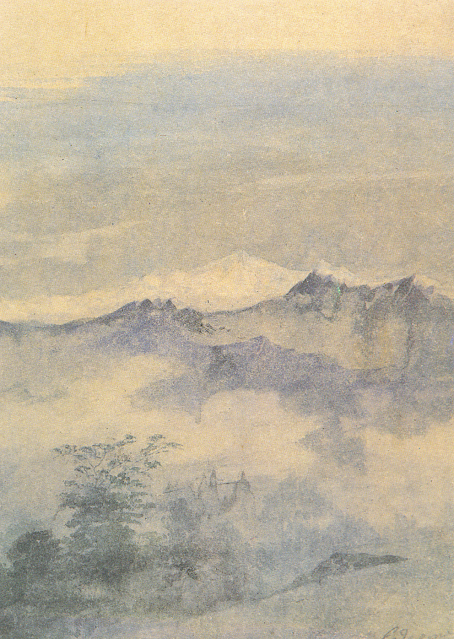
Mount Huber (3,348 m - 10,984 ft)
Canada (British Columbia)
In Chinook over O' Hara, oil on canvas, 1970, Private collection
The mountain
Mount
Huber (3,348 m - 10,984 ft) summit located two kilometers east of Lake
O'Hara in the Bow Range of Yoho National Park, in the Canadian Rockies
of British Columbia, Canada. Its nearest higher peak is Mount Victoria,
1.0 km (0.62 mi) to the north-northeast. Mount Huber is a secondary
summit of Mount Victoria which is on the Continental Divide. Named in
1903 by Samuel Allen for Emil Huber, a Swiss climber, who, with Carl
Sulzer, were first to climb Mount Sir Donald in the Selkirk Mountains.
The first ascent of the Mount Huber was made in 1903 by George Collier,
E. Tewes, Christian Bohren, and Christian Kaufmann. The mountain's name
became official in 1924 when approved by the Geographical Names Board of
Canada. Mount Huber is composed of sedimentary rock laid down during
the Precambrian to Jurassic periods. Formed in shallow seas, this
sedimentary rock was pushed east and over the top of younger rock during
the Laramide orogeny. Based on the Köppen climate classification, Mount
Huber is located in a subarctic climate with cold, snowy winters, and
mild summers ] Temperatures can drop below −20 °C with wind chill factors below −30
°C. Precipitation runoff from Mount Huber drains into tributaries of the
Kicking Horse River which is a tributary of the Columbia River.
Robert Douglas Genn was a Canadian artist, who has gained recognition for his style, which is in the tradition of Canadian landscape painting. His work is in corporate and public collections, including Air Canada, Bank Of Montreal, Canadian General Insurance, Canadian Airlines, Canadian Utilities, The Churchill Corporation, Expo '86, Esso Resources, First City - California II, Highfield Oil & Gas, Molson Brewery Ltd., Montreal Trust, Shell Resources, University of Alberta, Westgate Chevrolet, Glenbow Museum and Government of Belgium.
Born in Victoria, British Columbia, Genn has often been compared with members of the 1920s Canadian Group of Seven. In 1961, he met Lawren Harris who was a neighbour in Point Grey, Vancouver. Genn had problems with painting skies, and Harris's advice was to turn the picture upside-down: "Paint down from the trees to the clouds at the bottom of the picture to get the perspective right." Genn said this was "valuable advice", which enabled him "to control the gradation, and work up into the trees in a more abstract manner."
He ran the Painter's Keys web site, a worldwide artists' community, with his staff and volunteers. The web site sends out an erudite free twice-weekly newsletter, which is sent to 135,000 artists in over 100 countries, and claims the largest collection of art quotes online with over 5,382 authors quoted.
In 2005, Genn campaigned against the Chinese website, arch-world.com, which was selling thousands of high-resolution images of around 2,800 artists' work illegally, without permission. After failing to gain support from the Canadian government or the African embassy in Ottawa, Genn used his web site to enlist subscribers' support to email objections to the arch-world, resulting within days in over 1,000 online complaints from artists, dealers and politicians to the company and governments. This stimulated a diplomatic protest letter to the Chinese Ministry of Commerce, Trading and Law Department from the Canadian Embassy in Beijing. Genn credited the campaign with the subsequent removal of images by 800 Canadian artists from arch-world, although many works were reinstated on arch-world soon after.
Genn has been a member of the Board of Directors at Emily Carr College of Art & Design.
Genn announced in his Twice-Weekly Letter of 25 October 2013 that he had been diagnosed with pancreatic cancer. He died at his Surrey, British Columbia home on 27 May 2014.
___________________________________________
2021 - Wandering Vertexes...
by Francis Rousseau






